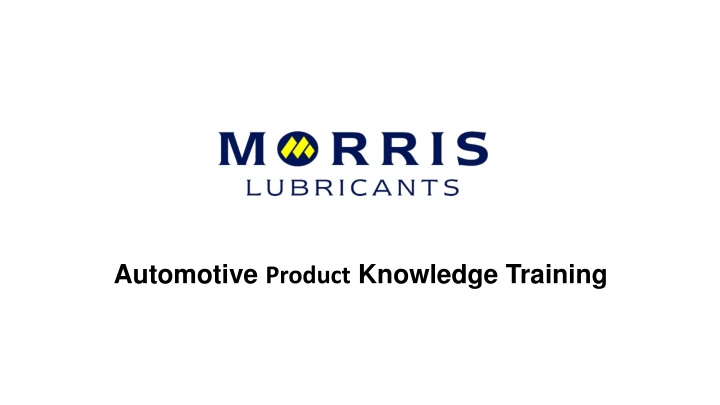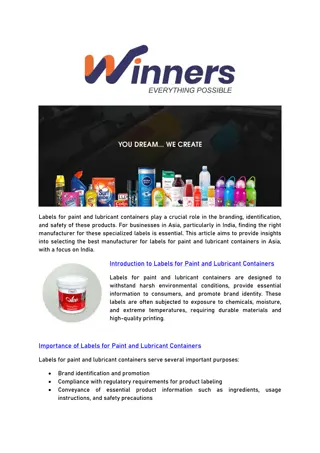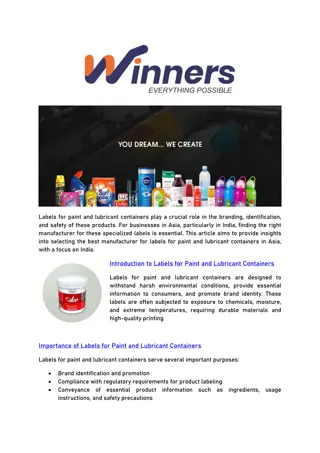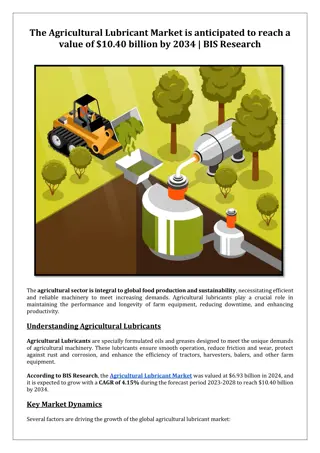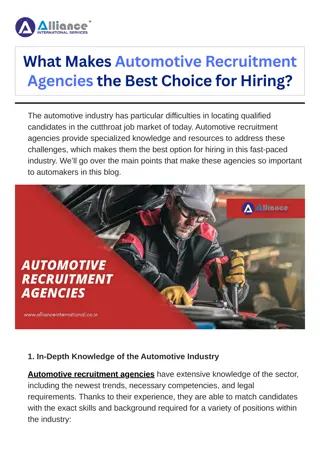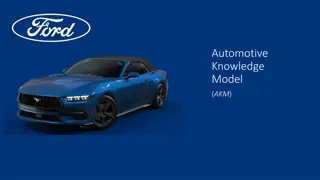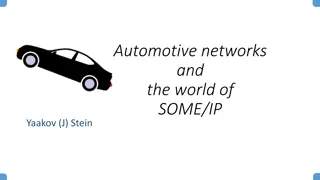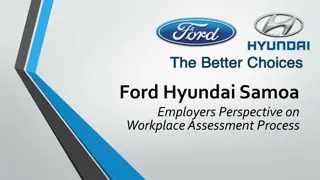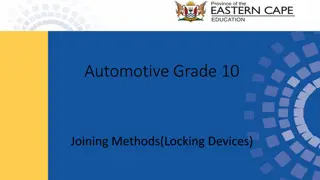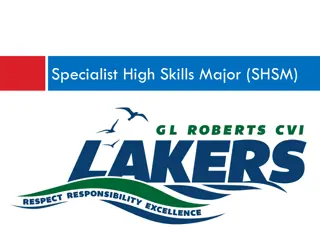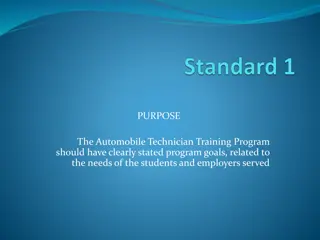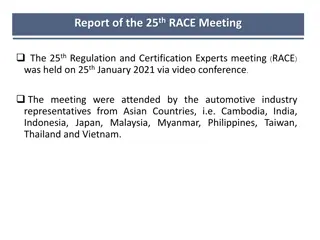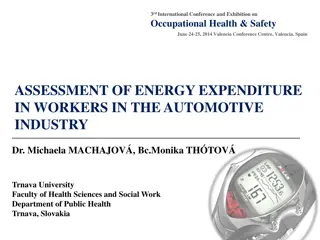Comprehensive Automotive Lubricant Function and Properties Training
Explore the essential aspects of lubricants in automotive systems, covering functions like friction reduction, heat transfer, and contamination containment. Learn about base oils, additives, and formulating lubricants using mineral oils, synthetic oils, and vegetable oils, with advantages and disadvantages of each type.
Download Presentation

Please find below an Image/Link to download the presentation.
The content on the website is provided AS IS for your information and personal use only. It may not be sold, licensed, or shared on other websites without obtaining consent from the author.If you encounter any issues during the download, it is possible that the publisher has removed the file from their server.
You are allowed to download the files provided on this website for personal or commercial use, subject to the condition that they are used lawfully. All files are the property of their respective owners.
The content on the website is provided AS IS for your information and personal use only. It may not be sold, licensed, or shared on other websites without obtaining consent from the author.
E N D
Presentation Transcript
Lubricant Function and Properties Separation of mating surfaces / friction Reduction Example Bearing Shell Journal Oil Film
Lubricant Function and Properties Cooling Heat Transfer Cool Oil
Typical Engine Temperatures 250 / 350 oC 100 / 150 oC 80 / 130 oC
Typical Engine Temperatures Temp oC From 150 650 370 Component To 260 815 425 Upper Cylinder Wall Exhaust Valve Piston Crown Hydraulic Valve Lifter Crankcase Top Ring Exhaust Gases Combustion Chamber Coolant Jacket Connecting Rod Bearings Main Bearings 120 93 150 260 1650 75 93 93 150 150 340 540 2760 110 190 175
Lubricant Function and Properties Contamination Containment Carbon Water Acids Partially Burnt Fuel Varnish Lacquers
Base Oils and Additives Base Oils and Additives
Formulating Lubricants Base Oil The main component of the formulation Selection based on the lubricant application Main types Mineral Oils Mainstream products Vegetable Oils Biodegradable, historic Synthetic Fluids High performance, extremes
Formulating Lubricants Mineral Oils: Advantages: Relative low cost, variety of natural viscosities, widely available Disadvantages: Requires additive enhancement, limited high temperature performance (oxidation resistance) Synthetic Oils: Advantages: Good cold flow, excellent high temperature performance (oxidation resistance), low deposit formation, maintains better viscosity at elevate temperatures, forms a strong oil film Disadvantages: Poor natural lubricity, possible seal shrinkage, expensive Vegetable Oils: Advantages: High film strength, excellent natural lubricity Disadvantages: Poor high temperature performance (oxidation resistance), tendency to thicken, forms lacquers and varnishes, frequent oil drain, not compatible with mineral oils, poor cold start
Formulating Lubricants Additives: Enhance base oil performance Imparts required lubricant functions Main types: Pour Point Depressant Detergent EP (Extreme Pressure) Dispersants Seal swell Anti-wear Friction modifier Corrosion inhibitor Tackiness Additive Rust inhibitor Anti-foam Oxidation inhibitor
What is viscosity? Thin Oil Low Viscosity Thick Oil High Viscosity
Viscosity Classifications SAE Society of Automotive Engineers ISO International Standards Organisation
Multigrade Engine Oils 0oC 20W -15oC 15W 10W -20oC 5W 0W -25oC -30oC -35oC A measure of the oil s cold start fluidity.
LEGISLATION EMISSIONS AND ENGINE HARDWARE
Targeted Pollutants NOx Nitrous oxide (NO), poisonous gas Nitrogen dioxide (NO2), can cause respiratory problems Produces Ozone (O3) in strong sunlight Contributes to acid rain Hydrocarbon (HC) and Particulates (PM) Unburnt fuel and soot Harmful to health Smog formation Carbon Monoxide (CO) CO, poisonous gas CO2 Carbon Dioxide, colourless, inert gas Greenhouse gas SO2, SO3 Sulphur Dioxide / Trioxide Formed during combustion from sulphur Breathing difficulties with asthmatics Acid rain Sulphuric acid
Emissions Legislation On Road EU Emission Standards for Heavy Duty Diesel Engines (Lorries/Buses) Standard Euro 1 CO HC NOx PM Smoke 4.5 4.5 1.1 1.1 8.0 8.0 0.612 0.36 - 1992,<85kW 1992,>85kW 4.0 4.0 1.1 1.1 7.0 7.0 0.25 0.15 - Oct 1996 Oct 1998 Euro 2 1.0 2.1 0.25 0.66 2.0 5.0 0.02 0.10 0.15 0.8 Oct 1999* Oct 2000 Euro 3 1.5 0.46 3.5 0.02 0.5 Oct 2005 Euro 4 1.5 0.46 2.0 0.02 0.5 Oct 2008 Euro 5 1.5 0.13 0.4 0.01 Sept 2014 Euro 6 Units in g/kWh, Smoke in m-1 *Enhanced Environmentally Friendly vehicles only
Emissions Legislation Off-Highway Environmental Protection Agency (U.S.A.) European Union (EU) Emissions Legislation for Non-road Diesel Engines EPA EU Date Tier 1 Stage I 1996 - 1999 Tier 2 Stage II 2001 - 2004 Tier 3 Stage IIIA 2006 - 2008 Interim Tier 4 Stage IIIB 2008 - 2013 Final Tier 4 Stage 4 2012 - 2015
Diesel Emissions - Reduction Technologies Exhaust Gas Re-circulation (EGR) NOx reduction The oil must combat: thickening, wear and corrosion Diesel Particulate Filters (DPF) Particulate matter (PM) reduction The oil must not form excessive ash Selective Catalytic Reduction (SCR) - Adblue NOx reduction The oil must be catalyst safe New generation SAPS products (Sulphated Ash / Sulphur / Phosphorous )
Exhaust Gas Recirculation (EGR) NOx reduction More aggressive engine environment Significant impact on lubricants
Selective Catalytic Reduction (SCR) NOx reduction Less demand on the engine environment Sulphate formation can deactivate SCR by fouling the catalyst
Diesel Particular Filters (DPFs) Particulate Matter (PM) reduction Sensitive to ash levels Sulphated Ash level critical
Diesel Oxidation Catalysts (DOC) Reduction of carbon monoxide and hydrocarbons by more than 90% Reduction of particulate emissions Phosphorous / Sulphur can poison catalyst
Euro 6 Approach - All 3 Technologies ANd9GcTUY1hiGSYdo-r6QEiBRoj1948hcbUv-60XQFhq66TK8tHnDe_84w 1. Intake Throttle 2. EGR Valve 3. DPF 4. SCR Catalyst 5. Cleanup Catalyst As proposed by Scania
Euro 6 Approach - All 3 Technologies Volvo-Truck-Engine-728x489
New Chemical Restrictions on Lubricants New generation of after-treatment compatible lubricants New additive systems developed to maintain after-treatment efficiency SAPS Originates from the combustion of engine oil additive systems Sulphated Ash Originates from engine oil additive systems Phosphorous Originates from base fluids and additive systems, fuel Sulphur
Engine Oil Performance Classifications Association des Constructeurs Europeens de l Automobile ACEA (Association of European Automotive Manufacturers) Category Description Gasoline / Petrol Engines A Light Duty Diesel Engines Gasoline / Light Duty Diesel Engines with exhaust after-treatments B C Heavy Duty Diesel Engines, including latest technology designs E API American Petroleum Institute Category C Description Commercial Compression Ignition - Diesel Service Spark Ignition Petrol / Gasoline S
ACEA - Performance Classifications Passenger Car Heavy Duty Diesel Engines without After-treatment Engines with After-treatment Gasoline / Diesel Gasoline / Diesel A1 / B1* C1 Low SAPS E4 Conventional * A3 / B3* C2 Mid SAPS E7 Conventional * A3 / B4* C3 Mid SAPS E6 Low SAPS A5 / B5* C4 Low SAPS E9 Mid SAPS * Cannot be used with Diesel Particulate Filters
Understanding API Designations API SN / CI-4 Spark Ignition Compression Ignition Service Category Commercial Category Petrol Diesel
API Service Categories - Petrol - API SA For mild conditions, no additives API SB 1930 Minimum duty under mild conditions, low additive level API SC 1964 Service typical of petrol engines 1964 thro 1967 API SD 1968 Service typical of petrol engines 1968 thro 1970 API SE 1972 For 1979 and older petrol engines, including some trucks API SF 1980 For 1988 and older petrol engines, including some trucks API SG 1989 For 1993 and older petrol engines: cars, vans and light trucks API SH 1993 Test limits as for API SG, but with a tougher approval system API SJ 1996 For all petrol engines currently in use API SL 2001 2002 model year vehicles,. Oxidation resistance, deposit control, fuel economy, low temp. properties 2004 2011 Improved high temperature deposit control, better sludge control and seal compatibility. Improved fuel economy, turbo protection, emission system control compatibility and protection of engines using ethanol-containing fuels. API SM Latest petrol engines designed to meet the 2004 emission levels API SN
API Commercial Categories - Diesel API CA 1940/50 Mild to moderate duty with high quality fuels API CB 1950/60 Mild to moderate duty engines from 1949 to 1960 API CC 1961 For naturally aspirated diesel engines 1961 onwards API CD 1955 For certain naturally aspirated and turbocharged engines API CD-II 1987 Introduced for two-stroke diesel engines API CE 1987 High performance four-stroke NA and turbocharged API CF-4 1990 Better oil consumption and piston deposit control than CE API CF 1994 Indirect-injected diesel engines with high sulphur fuels API CF-II 1994 Severe duty two-stroke diesel engines API CG-4 1995 Severe duty high perf. 4 strokes with low sulphur fuels API CH-4 1998 Next generation low emission designs API CI-4 2002 To sustain engine durability where EGR is used API CJ-4 2007 Advanced emission control technologies, including diesel particulate filters (DPF) and in most cases exhaust gas recirculation (EGR).
BASIC GEAR OIL PERFORMANCE LEVELS
Basic EP (Extreme Pressure) Properties Basic EP (Extreme Pressure) Properties Sacrificial Chemical Layer
POOR RESULT PINION SHAFTS SEVERE 400 HR TEST
GOOD RESULT PINION SHAFTS SEVERE 400 HR TEST
Automotive Gear Oils API GL Specifications API GL-1 Straight mineral oil API GL-2 Mild EP for worm gears API GL-3 Mild EP for spur and spiral bevel gears in axles and transmissions API GL-4 Medium EP, MIL-L-2105 quality, moderate severity hypoid gears, manual transmissions API GL-5 High EP, MIL-L-2105D quality, all hypoid axles, some manual transmissions API GL-6 Extra high EP, now obsolete
Automatic Transmission Fluids Automatic Transmission Fluids
ATF ATF - - GM Service Fill History GM Service Fill History Year Specification Comments Type A 1949 First specification to define a standard for ATF. 1957 Type A Suffix A Improved thermal stability. Tighter friction controls. Improved foam protection. Seal compatibility. Acceptable low temperature performance. Improved friction performance. Standard for wear protection. 1967 Dexron 1973 Dexron IID 1990 Dexron IIE Improved low temperature performance. Improved thermal stability. Utilise current transmissions. Higher / stable friction performance. Improved thermal stability. Improved durability 1993 Dexron IIIF 1998 2003 Dexron IIIG New Dexron III(H) Improved oxidation performance, thermal stability, elastomer compatibility and friction performance
ATF ATF - - Ford Service Fill History Ford Service Fill History Year 1959 1961 1967 1972 1987 Specification Comments M2C33-A/B M2C33-C/D M2C33-F M2C33-G Mercon First ATF specified. Updated specification. Type F performance defined Specification for Europe based on Type F New service fill specification. New test procedures. Demanding thermal stability and friction performance. Tightened performance limits Friction durability. Improved friction material stability, reduce torque converter chatter, lower operating temperature 1992 Revised Mercon 1995 Mercon V Friction durability
A few acronyms: STOU Super Tractor Oil Universal SUTO Super Universal Tractor Oil UTTO Universal Tractor Transmission Oil THF Transmission Hydraulic Fluid
Historic Overview Year Lubricant Types Combination of Engine Oil, Standard Gear Oil, STOU (15W-30). Pre-1980 1980 - 1989 Mixture of Engine Oil, STOU (15W-30 & 10W-30), Dedicated Transmission Fluids, some Standard Gear Oils. 1990 -1999 Mixture of Engine Oil, STOU (10W-30) and Dedicated Transmission Fluids, some Standard Gear Oils. Specific Engine Oil, Dedicated Transmission Oil, fewer allowances for STOU (10W-30), some Standard Gear Oils. 2000-
Main Categories of Agricultural Lubricant Engine Oils Specific to engine OEMs requirements, emissions hardware, etc. Dedicated Transmission Fluids (not engine) Universal Tractor Transmission Oil (UTTO) Main drive system Wet brakes Power-takes offs Differentials Final reduction gears Torque converter Hydraulic System Universal Oils (Engine and transmission) In decline no future developments
Critical Choices Engines Lubricant must be compatible with any emission reduction technologies. Protect under a wide range of workloads and environments: High speed road work / slow, high load, off-highway SCR_engine Developments: Interim Tier 4 / Stage IIIB Selective Catalytic Reduction (Adblue) + EGR Level: API CI-4, ACEA E7 Tier 4 / Stage 4 Diesel Particulate Filters (+ EGR + Adblue) Level: API CJ-4, ACEA E9
Critical Choices Transmission and Hydraulic Systems Performance is optimised by using the correct fluid as designated by the OEM. Increased complexity in design: Increased levels of electronic control Variety of operational modes (semi-auto / full auto) Continuously Variable Transmissions (CVTs): Improved durability to cope with a variety of workloads: Address critical frictional requirements, i.e. clutch packs, wet brakes Protect gear components, bearings and bushes Remove heat and debris Provide the correct hydraulic response in terms of speed and precision
Critical Choices Transmission and Hydraulic Systems Typical Specifications: UTTO GIMA M1143 Massey Ferguson M1135 / M1145 CNH MAT 3525 (Ford ESN-M2C134D Fluid) John Deere J20C ZF TE-ML-03E / 05F / 06K
Critical Choices Multipurpose Lubricants (STOU) Balance engine oil chemistry with transmission / hydraulic function Long term future limited: More severe engine environments low emissions Increased transmission sophistication
Critical Choices Multipurpose Lubricants (STOU) Typical Specifications: MF M-1145 MF M-1144 / M-1139 Ford M2C-159B / M2C-121B John Deere JDM J27 ZF TE-ML 06B (includes C,Q,R) ZF TE-ML 06D, 06F, 07B API GL-4 Allison C4 Caterpillar T0-2 API CG-4 MB 227.1 MB 228.3 MIL-L-2104D
